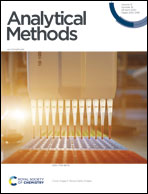Discrimination between fresh, chilled, and frozen/thawed chicken based on its skin's spectrochemical and optical properties
Abstract
Monitoring of the spectrochemical and optical properties of biomaterials has been widely utilized in many biomedical applications for both diagnosis and therapy. Recently, these nondestructive, noninvasive technologies have been used to inspect the quality and safety of food products. In this work, samples from chicken breast skin were investigated spectrochemically and optically to distinguish between fresh, frozen/thawed, and chilled chicken to reveal the adulteration of fresh meat and commercial fraud. Spectrochemical analysis was carried out using the Laser-Induced Fluorescence (LIF) technique. In the LIF setup used, a diode-pumped solid-state laser was used as a pump laser at λ = 266 nm. The LIF spectra were then analyzed statistically using the principal component analysis (PCA) method, while optical analysis was conducted via measurement of the parameters of the absorption and scattering of laser light (λ = 405 nm) on the chicken's skin. The optical absorption and scattering coefficients were acquired using an integrating sphere with a combination of the Beer–Lambert law and the Kubelka–Munk mathematical model. The spatial distribution of light at the sample surface was modeled using Monte-Carlo simulation and finite element solution of the diffusion equation to visualize the results. The potential of the LIF technique combined with principal component analysis in discriminating between the three chicken categories was validated by measuring the optical parameters as well as the simulation model. Besides, the discriminative ability of the proposed method was evaluated using receiver operating characteristic (ROC) curves, which showed sensitivity in discriminating fresh and frozen samples of 0.82 and 0.74 in fresh-chilled separation. These investigations demonstrate the capability of using LIF and proper software for in situ commercial fraud detection, i.e., in supermarkets and/or meat supplier centers.



 Please wait while we load your content...
Please wait while we load your content...